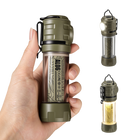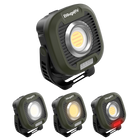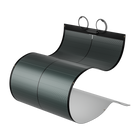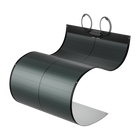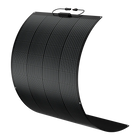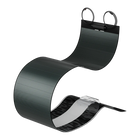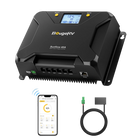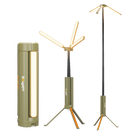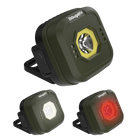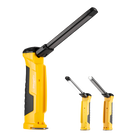7 Easy and Effective Ways to Protect RV Solar Panels From Hail!


If you're an RV owner who enjoys the benefits of solar power, you might be wondering how to protect your solar panels from hail. Hail can pose a significant threat to your RV solar system, especially if you live or travel in areas prone to hailstorms. Hail can damage the glass surface of your solar panels, reduce their efficiency, and even cause them to stop working altogether.
In this blog post, we'll explore just how delicate RV solar panels are, the types of damage hail can cause, and provide 7 easy and effective ways to protect your solar panels against hail damage. We'll also offer advice on selecting the best hail-resistant solar panels and more.
Let’s dive into it!
Hail Can Damage the Solar Panels
RV solar panels can withstand most hailstorms. However, if the hail is large enough to dent your vehicle, it can potentially damage your solar panels as well.
The most vulnerable part of a solar panel is the glass cover that protects the photovoltaic cells underneath. This glass cover is usually made of tempered glass, which is stronger and more resistant to impact than regular glass. However, even tempered glass can crack or shatter if hit by large or fast-moving hailstones.
Some common types of hail damage include:
-
Cracks: Small cracks in the glass surface may not significantly affect performance, but they can reduce aesthetic appeal and make the solar panels more prone to further damage.
-
Shatters: Large or severe cracks in the glass surface of your solar panels can cause them to shatter completely, exposing the photovoltaic cells underneath. This can result in a significant loss of power output and even create fire hazards.
-
Dents: Hailstones can also dent the metal frames or mounting brackets of your solar panels.
-
Disconnections: Hailstones can knock off or loosen the wiring or connectors of your solar panels, causing them to disconnect from each other or the battery bank. These disconnections can interrupt the electricity flow from your solar panels, preventing you from getting enough power.
7 Easy and Effective Ways to Protect Your RV Solar Panels From Hail
Fortunately, there are some simple and effective ways to protect your RV solar panels from hail damage. Here are 7 of them:
1. Buy Resilient and Waterproof Solar Panels

One of the best ways to protect your RV solar panels from hail is to invest in resilient and waterproof solar panels. For example, BougeRV’s flexible solar panels, which utilize thin-film solar cell technology, are designed to be hail-resistant for use on an RV.
Most solar panels manufactured today are generally tough. Solar panels rated UL 61730 can withstand strikes of hail between 1 and 3 inches, moving at speeds up to 88.3 miles per hour (142 kph). So when shopping for RV solar panels, look for those that meet this standard because they can survive most hailstorms.
If you prefer rigid solar panels, consider investing in waterproof and dustproof ones with an IP67 waterproof rating. Cracks in solar panels caused by hail can lead to leaks, which can result in further damage to the solar panels. IP67-rated solar panels can continue to function and produce power even when submerged underwater.
Most solar panels meet the above standards and are waterproof, so it’s less likely that your solar panels will be severely damaged by a hailstorm.
However, states such as California, Texas, Oklahoma, and Nebraska often experience heavy and dangerous hailstorms that can damage rigid solar panels. So, in these areas, it may be wise to invest in flexible solar panels. Here’s a YouTube video demonstrating how tough and resilient a flexible RV solar panel can be!
2. Install Solar Panels Properly
Install your solar panels properly and securely on your RV roof to prevent them from moving or falling off during a hailstorm and reduce the risk of damage.
If possible, consider an adjustable mounting system that allows you to angle the panels away from the storm's path. By minimizing the force and surface area exposed to the falling hail, you'll help protect your solar panels from damage.
3. Use a Solar Panel Protection Cover
When you expect a hailstorm or when you park your RV for an extended period, consider placing a protective cover over your solar panels to prevent damage.
A solar panel protection cover can shield your solar panels from hail, dust, dirt, bird droppings, and other debris that can harm them or reduce their efficiency. There are different types of solar panel protection covers available, such as:
A. RV Solar Panel Protective Cover
Hardcovers offer the best protection against impacts. They completely shield your solar panels, absorbing the full force of hailstones while preserving the panels underneath. However, the hardcovers block light, so your solar panels can't generate power while covered. It’s essential to remove the hard case after the storm passes.
Softer covers provide less protection, mitigating both sound and impact against the glass. While not as effective as hardcovers, they are easier to handle. In most hailstorms, a soft cover can be enough to protect your solar panels.
B. Hail Cover
A hail cover can be effective in protecting your solar panels from small to medium-sized hailstones but may not withstand large or severe hailstorms. Often made of thick, padded material, a hail cover can absorb the impact of hailstones and prevent them from cracking or shattering your solar panels.
However, hail covers can reduce the amount of sunlight reaching your solar panels, thus reducing power output. Therefore, you should only use hail covers when necessary and remove them as soon as possible after the hailstorm has passed.
C. Tarp
Using a tarp is a straightforward and inexpensive way to cover your solar panels quickly. A plastic or canvas tarp can offer some level of protection from hail.
D. RV Covers
RV covers can offer a degree of protection against hail. They can cushion the impact of hailstones on solar panels and various parts of your RV, such as the roof, windows, doors, vents, and skylights.
However, RV covers may not be the best solution for stopping large or fast-moving hailstones from denting or piercing through your RV's roof or walls. Additionally, RV covers may tear or rip if hit by sharp or jagged hailstones.
4. Spray on a Methacrylate Layer
Applying a methacrylate layer can create a hard, transparent, protective film that helps prevent hail from cracking or shattering the glass.
Methacrylate is inexpensive, easy to apply, and long-lasting, and it does not affect the performance of the solar panels. However, applying too much methacrylate can reduce the solar panel output. And don’t spray methacrylate on the metal parts of the solar panel to avoid potential damage and reduced electrical conductivity.
5. Protect the Solar Panels with Wire Mesh
For an affordable and simple solution, you can cover your RV solar panels with wire mesh to protect them from hail.
The advantages of using wire mesh include its low cost, ease of installation, and removability. However, it can reduce the amount of sunlight reaching the solar panels, may rust or corrode over time, and can create noise when hail strikes it.
6. Maintain and Inspect Your Solar Panels Regularly
Regular checks ensure that your solar panels are functioning properly, free of dirt and debris, and without cracks or damage. Spotting potential issues early allows you to address them before they worsen. By maintaining and inspecting your solar panels regularly, you can extend their lifespan, improve efficiency, and avoid costly repairs or replacements.
Here are some steps for maintenance and inspection:
-
Clean your solar panels at least once a month or more frequently if exposed to dust, pollen, or bird droppings.
-
Inspect your panels for any cracks, chips, dents, or scratches. Minor damages can be filled in with epoxy or silicone sealant. For major damages, consider solar panel replacement or professional repair.
-
Check your wiring and connections for loose or broken parts that might cause short circuits or fire hazards. Tighten or replace as needed, and insulate any exposed wires with electrical tape or heat shrink tubing.
-
Examine your batteries and charge controller for signs of wear or malfunction. Consult your manual or contact the manufacturer for troubleshooting or replacement if you encounter problems.
7. Check the Weather Forecast
Another effective strategy to protect your RV solar panels from hail is to check the weather forecast before traveling. This way, you can steer clear of areas likely to experience hailstorms or plan for alternative routes or shelter.
Buy the Best Hail-Resistant Solar Panels at BougeRV
For high-quality solar panels that withstand hail and other harsh weather conditions, consider BougeRV's offerings.
BougeRV solar panels are made with premium flexible CIGS or Monocrystalline solar cells and feature a robust design. They boast a high conversion efficiency of up to 23.5%, meaning they generate more power in less space.
BougeRV’s solar panels also have a strong aluminum frame and tempered glass capable of resisting impact, corrosion, and water. They are easy to install and compatible with most RVs, trailers, campers, boats, and other vehicles.
For the best hail-resistant solar panels, visit BougeRV.com to browse through a wide selection of products tested and certified for hail resistance:
- BougeRV’s Monocrystalline Solar Panel—Traditional Rigid Solar Panels for RV Rooftop.

- BougeRV’s Arch Fiberglass Curved Solar Panels—Resilient and Curvable.

- BougeRV’s Yuma CIGS Flexible Solar Panels—Our Best Hail-Resistant Solar Panels for Any RV Roof Shape.

- BougeRV’s Paso CIGS Foldable Solar Blankets—Our Best Portable Hail-Resistant Solar Panels for Charging Small Devices and Battery Banks.

BougeRV is a leading brand specializing in mobile solar energy solutions, offering products like solar panels, portable refrigerators, portable power stations, and related accessories and components—so you can enjoy longer, more comfortable off-grid adventures.
We also provide home solar solutions for emergencies when the lights go out. Explore more at BougeRV.com!
Final Thoughts
Hailstorms pose a significant threat to RV solar panels, potentially causing cracks, dents, or shattering. However, by following the seven easy and effective ways mentioned above, you can protect your solar panels from hail damage.
By applying these tips, you'll help ensure that your RV solar panels remain intact and functional for years, allowing you to reap the benefits of clean, renewable energy for your RV—saving money and enhancing comfort.
We hope this blog post has been helpful and informative. If you're interested in hail-resistant RV solar panels, check out the BougeRV brand, which has provided quality solar solutions to over 3 million customers worldwide for years.
FAQs on How to Protect RV Solar Panels From Hail
Is Hail Damage Bad for RV?
Hail damage can cause cosmetic and structural damage to the roof, windows, siding, awning, and other parts of the vehicle.
Depending on the size and speed of the hailstones, the damage can range from minor scratches to major dents or holes. Hail damage can also affect the value and appearance of your RV, as well as increase the risk of leaks or rust.
Can Hail Damage a Camper Roof?
Yes, hail can indeed damage a camper roof, particularly when the roof is constructed from thin or less durable materials such as rubber or fiberglass. Hail can create cracks or punctures in the roof. Additionally, hail can damage vents, skylights, antennas, and other accessories mounted atop the roof.
What Size Hail Will Damage Solar Panels?
The size of hail that will damage solar panels depends on several factors, such as the type and quality of the panels, the angle and position of the panels, the speed and direction of the hailstones, and the duration and intensity of the hailstorm.
Generally, hailstones larger than 1 inch in diameter can cause significant damage to solar panels. Smaller hailstones can also cause damage if they hit with enough force or frequency. By the way, if it’s large enough to dent your RV, it might damage your solar panels as well.
How Do You Prevent Hail Damage on an RV?
There are several ways to prevent hail damage on an RV, such as:
- Parking your RV under a covered or sheltered area when possible
- Using a sturdy and waterproof RV cover that can protect your vehicle from hail and other elements
- Installing protective devices such as awnings, deflectors, or guards on your windows, windshield, or mirrors
- Avoiding driving in areas or seasons where hailstorms are common or expected
- Checking your insurance policy to see if it covers hail damage or not
Is There Such a Thing As a Hail-Proof Roof?
No roof is completely hail-proof. Even the most durable materials can be damaged by large or fast-moving hailstones. However, some roofs are more resistant to hail damage than others.
For example, metal roofs are generally more resilient than asphalt shingles, and rubber roofs are more flexible than fiberglass. The best way to protect your RV roof from hail is to use a combination of methods, such as installing durable solar panels, using protective covers, and checking the weather forecast.
Does RV Insurance Cover Storm Damage?
Most RV insurance policies cover storm damage, including hail damage, but you should always check the details of your policy before filing a claim. Some policies may have deductibles, limits, or exclusions that affect your coverage.
For example, some policies may only cover the RV's damage, but not the solar panels or other accessories. You should also document the damage as soon as possible, take photos, and contact your insurance company promptly.
How to Protect Solar Panels From Theft?
Solar panels are valuable and attractive targets for thieves, especially if they are mounted on the roof of your RV. To prevent theft, you should take some precautions, such as:
- Registering your solar panels with the manufacturer or a database
- Locking your solar panels with security bolts or cables
- Installing an alarm system or a motion sensor on your RV
- Parking your RV in a well-lit and secure area
- Engraving your name or a serial number on your solar panels
How to Protect Solar Panels From Stones?
Stones can also damage your solar panels, especially if they are thrown by vandals or by passing vehicles. To protect your solar panels from stones, you should:
- Use a solar panel protection cover when not in use
- Install a wire mesh or a plexiglass shield over your solar panels
- Don’t park your RV near gravel roads or construction sites
- Report any incidents of vandalism or stone-throwing to the authorities
How to Protect Solar Panels From Wind?
To protect your solar panels from wind, you should:
- Adjust the angles of your panels according to the wind direction and speed
- Use sturdy brackets and bolts to mount your solar panels on the roof
- Check the condition of your solar panels and mounting hardware regularly
- Remove any loose objects or debris that could fly into your solar panels








